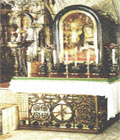The Birthing of a Godman
The Gospel of Matthew tells of the appearance of an angel to Joseph in a dream, urging him to marry his divinely impregnated virgin wife-to-be; of a new star in the sky and wise men from the east; of the flight of the holy family to Egypt and of the massacre of the innocents of Bethlehem. Matthew invokes ancient Jewish prophecy to validate his surreal claims.
The Gospel of Luke mentions none of these dramatic events but instead reports the appearance of an angel to Mary; a worldwide census; the birth in a manger, a choir of angels; adoring shepherds; and a joyful presentation in the Temple. None of this is mentioned by Matthew.
The lack of mutual support between the two tales, and the fantastic nature of the purported events are damning enough. But what blows the fable clean away from the known universe is the ignorance of any such yarn by the earliest Christians, whether Matthew’s version or the fabrication of Luke. Not Paul, nor any of the epistle writers, know the tale and the gospels of Mark and John say nothing of the birthing of Jesus either. Those who should have known most about these wondrous events know least.
But then, the fable of the nativity is late and fake and was a necessary step in transforming the righteous hero of Mark’s gospel into a demigod and – at length – into a preexistent co-creator of the universe.
| The Birth of Jesus Christ – Competing mythologies | ||
|---|---|---|
| Matthew | Luke | |
| Bethlehem: | Mary/Joseph already live in Bethlehem | Mary/Joseph live in Nazareth |
| Angelic announcements: | to Joseph in dreams | to Mary in visions |
| Birth: | Birth in house | Birth in manger |
| Celestial sign: | Star in the East | Chorus of angels above a sheep pasture |
| Genealogy: | “42” generations back to Abraham (actually 41 names) | 42 generations back to David. Then another 14 generations back to Abraham, and another 21 generations back to God himself. |
| Royal ancestry: | Lineage accentuates Jewishness | Extended ancestry now inclusive of Gentiles |
| Adoration: | from Magi Dream-inspired flight to Egypt Herod’s murder of the innocents Move to (new home) Nazareth |
from Shepherds Presentation in the Temple; recognised as a “light to the Gentiles” by prophets; Prodigy in the temple at aged 12. |
"Star of Wonder" all right!
It also seems that the Jews knew that the Christ was to be born in Bethlehem – but the magi, experts on Jewish oracles, did not!
"Westward leading, still proceeding"?
“When they heard the king, they departed; and behold, the star which they had seen in the East went before them, till it came and stood over where the young Child was. When they saw the star, they rejoiced with exceedingly great joy.” – Matthew 2.9-10. (NKJV).

Did the “wise men” follow a star from the east?
“After Jesus was born in Bethlehem in Judea, during the time of King Herod, Magi from the east came to Jerusalem and asked, Where is the one who has been born king of the Jews? We saw his star in the east and have come to worship him.”
– Matthew 2.1-2.
In reality, Matthew was merely working up a yarn from scripture, “a Star out of Jacob“. A new star was indicative of divine intervention in human affairs and symbolized “the light”.
Following yonder star?
“They went on their way, and the star they had seen in the east went ahead of them until it stopped over the place where the child was.” – Matthew 2.9.
Is the “star” not really a star at all but rather, a guiding angel?
Aah, that makes it all so much more realistic …
Bearing Gifts?
“The phoenix makes for itself a coffin of frankincense and myrrh which in the fulness of time it enters and so dies.”
– Clement, Epistle to the Corinthians (2nd century).
Dream time
“Then, being divinely warned in a dream that they should not return to Herod, they departed for their own country another way.” – Matthew 2.12.
If only reality was quite so capricious.
Magi from the East – The Evolution of a Myth
“Arise, shine; for your light has come! And the glory of the Lord is risen upon you. For behold, the darkness shall cover the earth, and deep darkness the people; But the Lord will arise over you, and His glory will be seen upon you.
The Gentiles shall come to your light, and kings to the brightness of your rising. Lift up your eyes all around, and see: They all gather together, they come to you; Your sons shall come from afar, And your daughters shall be nursed at your side. Then you shall see and become radiant, and your heart shall swell with joy; Because the abundance of the sea shall be turned to you.
The wealth of the Gentiles shall come to you. The multitude of camels shall cover your land, The dromedaries of Midian and Ephah; All those from Sheba shall come; They shall bring gold and incense, And they shall proclaim the praises of the Lord.” – Isaiah 60.1-6.
Well, we all like a story with a happy ending.

Shrine of the Three Kings at Cologne Cathedral containing the bones of the magi. Honest.
Born under star" from soothsayer with a talking donkey!
“And Balaam said unto the ass, Because thou hast mocked me: I would there were a sword in mine hand, for now would I kill thee.
And the ass said unto Balaam, Am not I thine ass, upon which thou hast ridden ever since I was thine unto this day? was I ever wont to do so unto thee? And he said, Nay.” – Numbers 22.29,30.

Balaam himself is a literary device intruded into the story of Moses. He is a foil used to demonstrate that even Gentile prophets, intent on cursing the Israelites, are obliged by Yahweh to dispense “blessings” instead. A little after his discourse with the donkey, Balaam utters the words wrenched out of context centuries later by Christian novelists:
The oracle of Balaam son of Beor, the oracle of one whose eye sees clearly, the oracle of one who hears the words of God, who has knowledge from the Most High, who sees a vision from the Almighty, who falls prostrate, and whose eyes are opened:
I see him, but not now; I behold him, but not near. A star will come out of Jacob; a sceptre will rise out of Israel. He will crush the foreheads of Moab, the skulls of all the sons of Sheth. Edom will be conquered; Seir, his enemy, will be conquered, but Israel will grow strong. A ruler will come out of Jacob and destroy the survivors of the city.” – Numbers 24.12,17.
With its boast of might and vengeance, this particular notion of a “star out of Jacob” resonated with the Jews. Josephus saved his own skin with “an ambiguous oracle” found in Jewish sacred writings – and the presumption is that he was referring to Balaam.
In any event, Josephus flattered the vanity of Vespasian that he would be that “foretold” world ruler (War 6.312).
A messianic claimant of the 130s, Simon ben Kosiba, was also heralded by his followers as a star, as “Bar Kochba”, in other words, as a “son of the star”. But unlike Matthew and his fable of Jesus, there was no attempt made to finesse Simon’s stellar qualities into a fiery object in the sky!
Bethlehem – tribe, town or man?
Nothing here suggests a prophecy of a far-distant future. In fact, it was a pathetic forecast even for Micah’s own age. The tiny theocracy of Jerusalem laying waste the Assyrian empire? Only in the delusional mind of a religious fanatic.
Herod's massacre of the innocents? – The recycled story of a bad Pharaoh!
As adults, both Moses and Jesus interceded for Israel before God, acted as prophets, gave laws, performed feeding miracles, and so on. Quite simply, Matthew fabricated Jesus as the “new Moses”.
Flight to Egypt? – "Out of Egypt I called my son."
“When he arose, he took the young child and his mother by night and departed for Egypt, and was there until the death of Herod, that it might be fulfilled which was spoken by the Lord through the prophet, saying, “Out of Egypt I called My Son.” – Matthew 2.14-15.
“Out of Egypt I called My Son.” – Hosea 11.1.
“They shall not dwell in the Lord’s land but Ephraim shall return to Egypt and they shall eat unclean things in Assyria.” – Hosea 9.3.
“He shall not return into the land of Egypt but the Assyrian shall be his king … My people are bent to back-sliding from me.” – Hosea 11.5-7.
| “Prophecy” – Late and Fake | ||
|---|---|---|
| Did Micah copy his soothsaying from Isaiah or did Isaiah copy his from Micah – or are the prophets entirely bogus? | ||
| Micah 4.1-3. | Mary/Joseph live in Nazareth | |
| Now it shall come to pass in the latter days That the mountain of the Lord’s house Shall be established on the top of the mountains, And shall be exalted above the hills; And peoples shall flow to it. Many nations shall come and say, | Now it shall come to pass in the latter days That the mountain of the Lord’s house Shall be established on the top of the mountains, And shall be exalted above the hills; And all nations shall flow to it. Many people shall come and say, | |
| “Come and let us go up to the mountain of the Lord, To the house of the God of Jacob; He will teach us His ways, And we shall walk in His paths.” | “Come and let us go up to the mountain of the Lord, To the house of the God of Jacob; He will teach us His ways, And we shall walk in His paths.” |
|
| For out of Zion the law shall go forth, And the word of the Lord from Jerusalem. He shall judge between many peoples, And rebuke strong nations afar off; They shall beat their swords into plowshares, And their spears into pruning hooks; Nation shall not lift up sword against nation, Neither shall they learn war anymore. |
For out of Zion shall go forth the law, And the word of the Lord from Jerusalem. He shall judge between the nations, And rebuke many people; They shall beat their swords into plowshares, And their spears into pruning hooks; Nation shall not lift up sword against nation, Neither shall they learn war anymore. | |
"And he came and dwelt in a city called Nazareth"
“And he came and dwelt in a city called Nazareth: that it might be fulfilled which was spoken by the prophets, He shall be called a Nazarene.” – Matthew 2.23.
“For, lo, thou shalt conceive, and bear a son; and no razor shall come on his head: for the child shall be a Nazarite unto God from the womb: and he shall begin to deliver Israel out of the hand of the Philistines.” – Judges 13.5.
“And she vowed a vow and said, “O Lord of hosts, if you will indeed look on the affliction of your servant and remember me and not forget your servant, but will give to your servant a son, then I will give him to the Lord all the days of his life, and no razor shall touch his head.” – 1 Samuel 1.11.
That Matthew had Samuel in focus when constructing his nativity yarn is betrayed by his fellow story teller Luke. Now Luke did not require a pretext for placing the holy family in Nazareth (for Luke Nazareth was their regular home) but nonetheless, Luke follows Matthew’s lead by drawing upon the tale of Samuel:
“Now the young man Samuel continued to grow both in stature and in favour with the Lord and also with man.” – 1 Samuel 2:26.
| Why waste a good yarn? | ||
|---|---|---|
| Luke copies from Samuel | ||
| In her biggest scene, Mary delivers her only set-piece speech, the so-called ‘Magnificat’. Luke has modelled this paean after the so-called ‘song of Hannah’, delivered after her own divinely sponsored pregnancy. | ||
| 1 Samuel 2.1,10. | Luke 1.46,55. | |
| Song of Hannah | ‘Magnificat’ | |
| “And Hannah prayed, and said, My heart rejoiceth in the Lord, mine horn is exalted in the Lord: my mouth is enlarged over mine enemies; because I rejoice in thy salvation … | My soul doth magnify the Lord, And my spirit hath rejoiced in God my Saviour. For he hath regarded the low estate of his handmaiden … | |
| The bows of the mighty men are broken, and they that stumbled are girded with strength … they that were hungry ceased: so that the barren hath born seven; and she that hath many children is waxed feeble. | He hath put down the mighty from their seats, | |
| The Lord maketh poor, and maketh rich: he bringeth low, and lifteth up. He raiseth up the poor out of the dust … | He hath filled the hungry with good things; and the rich he hath sent empty away. | |
| The adversaries of the Lord shall be broken to pieces.” | He hath helpen his servant Israel, in remembrance of his mercy…” | |
Related articles

Matthew – "Magi but no census"
In Matthew’s fable it is “magi from the east” who traipse to Bethlehem, not the holy family. In Matthew Joseph and Mary already live there.
Raped by a ghost?
In Matthew, angels appear to Joseph in his dreams, advising him of his young bride’s divine impregnation. Nonsense three levels deep.
But Mary herself does not get a tip off until Luke writes in Mary’s own angel in Luke 1.35.

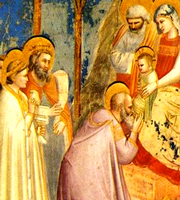
Resistance is futile
Star turn

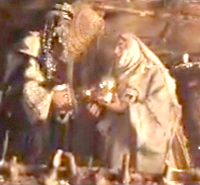
Myrrh? No thanks
Submission of the priests of Mithras
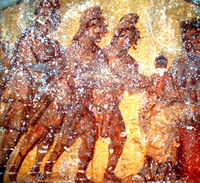
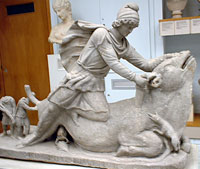
Not at all like kings

Ephraimite = Ephrathite

Naked and the Dead
Oops! A failed "prophecy"

Oops! A failed "prophecy"

Role model for Jesus
Seasoned traveller


